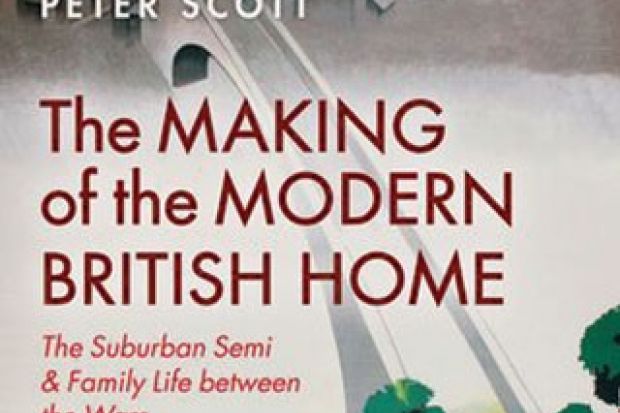Towards the end of the First World War, the government’s “Homes for Heroes” campaign aimed to divert potential unrest by focusing attention on the comforts and rewards of peacetime. The 1918 Tudor Walters Report promoted housing of a lower density than the traditional terraces snaking across both urban and rural Britain. In The Making of the Modern British Home, Peter Scott draws on data from the Ministry of Labour’s national household expenditure survey of 1937-38, along with oral history material, council estate surveys, house-building company records, building society archives, PhD theses and what he calls the “Peter Scott Collection” of ephemera such as housebuilders’ brochures, to investigate the social impact “of the rise of the modern suburban semi-detached house on British family life during the 1920s and 1930s”.
Although Scott considers both municipal rented accommodation and owner-occupied private developments, his principal interest, informed by the research of Alan Crisp and George Speight, is the impact on working-class households of a move to the suburban semi, broadly defined. Some 25 per cent of non-agricultural working-class households moved to the suburbs during this period, and suburbanisation had its most significant impact on this group, we are told. Between 1914 and 1938, owner-occupied dwellings rose from about 10 per cent to 32 per cent of the housing stock. Scott examines the “easy terms” mortgages promoted to working-class borrowers and critiques the alliance of housebuilders and building societies. Marketing strategies aimed to allay potential house purchasers’ anxieties and made emotional appeals, as in one contemporary advertising slogan: “Whose key do you carry in your pocket, your own or your landlord’s?” Scott also considers the provision of practical measures, such as chauffeur-driven cars taking prospective buyers from city centres to suburban housing development sites.
In these new developments, populated by relative strangers, inhabitants would come to rely on the display of prestige goods to communicate status rather than on “life portrait” status assessments based on family backgrounds. Status was also communicated and facilitated by restraint in relation to family size, with house buyers having significantly fewer, better resourced, children than renters. Marketing furniture to new suburban families was made easier by householders’ determination that the furnishings they put into these new suburban semis should live up to the rooms, and hire-purchase schemes made it easier to acquire those goods. The designers of furniture brochures emulated the look of women’s magazines, engaging in a visual and textual discourse of aspiration. Those who moved to the suburbs were sometimes seen as snobby by their urban ex-neighbours and consequently ostracised, while suburbia itself was often characterised by a lack of social diversity.
The book’s emphasis on working-class engagement with the suburban semi-detached house is enabled by Scott’s extremely broad definition of that housing form, which ranges from “some variant of the three-bedroom semi (or, sometimes, for council housing, short terraced block)” to “detached houses on speculative estates” that were “essentially detached versions of the semi”. But, unlike the suburban estates that dismantled existing patterns of sociability, the short terraces used in municipal housing developments were designed to foster the community cohesion of previous working-class housing patterns. To describe them as semi-detached is, however, a stretch, as even the end houses are as much end-of-terrace as they are semi-detached. Nevertheless, for Scott, the three-bedroomed interior layout is a critically important distinguishing feature of the suburban semi, which had as great an impact on the lives of the families it housed as their removal to a suburban location.
The Making of the Modern British Home argues that suburban estates were “the most important infrastructure legacy bequeathed to subsequent generations by the citizens of interwar Britain”. Although in the 1970s, authorities’ failure to police municipal housing developments led to the term “estate” being “stripped of its original aspirational connotations, becoming a byword for areas blighted by social decay and crime”, Scott argues that the “interwar semi has retained its status as the ‘ideal home’ for many families, almost three-quarters of a century after the last interwar houses had their foundations laid”. For this reviewer, a design historian, there is more to be said about both professional design prior to building and amateur design practices in the inhabited home. Nevertheless, Scott’s well-grounded and comprehensive account will be the definitive book on this subject for years to come.
The Making of the Modern British Home: The Suburban Semi and Family Life between the Wars
By Peter Scott
Oxford University Press, 288pp, £65.00
ISBN 9780199677207
Published 29 August 2013
Register to continue
Why register?
- Registration is free and only takes a moment
- Once registered, you can read 3 articles a month
- Sign up for our newsletter
Subscribe
Or subscribe for unlimited access to:
- Unlimited access to news, views, insights & reviews
- Digital editions
- Digital access to THE’s university and college rankings analysis
Already registered or a current subscriber? Login





